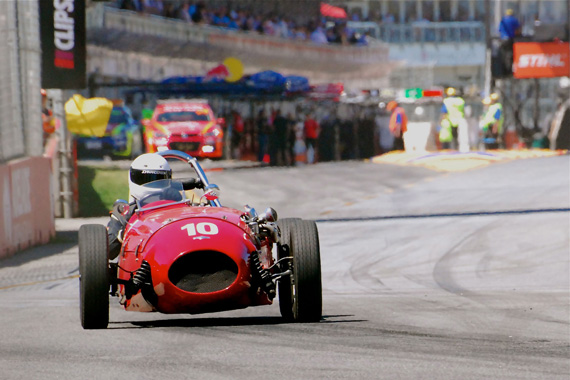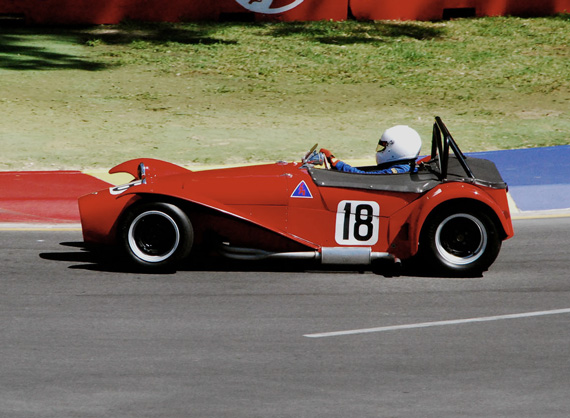
Prettiest pair: Graeme Wright’s Mallala leads its predecessor, the Streamliner of John Becker into turn 1.
Story and photos by Vince Johnson
With the Australian GT Championship missing from the program at the opening round of the Aussie V8 Supercars at the Adelaide street circuit, the only Italians to be found were the club and dealer displays of the two-wheeled variety. Taking the place of the Gallardos and 458 Italias was the Touring Car Masters category. Six years ago, this group of 60’s and 70’s muscle cars held their first race around the streets of the South Australian capital at this event and twenty-seven of them formed up behind the pace car for the first race late on Friday afternoon.
Rolling starts had been introduced in the interests of start-line safety but they also helped the clutches. Tony Karanfilovski’s Trans Am Mustang made the most of the start over pole-sitter John Bowe’s similar car and he held his lead throughout, with Andrew Miedecke’s Camaro SS splitting the Fords on the podium. Starting from 3rd in Saturday’s reversed-grid race, Mark King in Miedecke’s sister car Camaro RS led from lap 4. Bowe avoided a multi-car shunt at the start, coming from 9th place at the end of lap 1, to grab second from Keith Kassulke’s Falcon XB Coupe at the final corner.
The extra rubber laid down during the two 125km races for the V8 Supercars on Saturday saw the Touring Car lap times drop on Sunday morning. Miedecke led Eddie Albenica’s Falcon XB Coupe home with Bowe setting a new lap record and a podium hat-trick.
While the name Elfin has nothing to do with the well-known French oil company, Webster’s dictionary gives an insight into why there were a dozen and a half of them on track doing demonstration runs each day: Elfin: ‘small, slight and delicately-made or proportioned, quick, agile … having an otherworldly, unearthly or magical quality’. In the mid 1950’s South Australian Garrie Cooper had finished off the Cooper Butler with friend Norman Butler at his father Cliff’s auto body repair shop. Originally designed by Eldred Norman, this car is considered the forerunner of the Elfins.
One of three built, chassis number 2 could easily have passed for something Italian out on the track. With a surname already taken in Northern hemisphere motorsport circles, Cooper adopted the name Elfin. Twenty-three examples of the front-engined Streamliner followed, from 1959 – 63, again proving the adage “It it looks right it probably is.” Sports, racing and clubman versions continued the line. In the early 70’s as Formula 5000 thundered onto tracks around the country, Cooper’s designs brought Elfin major success. Bill Hemming’s MR8, in the hands of Bryan Sala, and Trevor Lambert in his ME5 led the demonstration runs and, as the course car pulled off, gave spectators the sound of their five-litre V8 racing engines.
The 1968 Singapore Grand Prix and the 1975 Australian Tourist Trophy are two of Garrie Cooper’s famous successes at the wheel of his own cars. He eventually built a total of 248 cars across 27 different models before his untimely passing in 1982. The company survives, in Melbourne Victoria, under Walkinshaw ownership.
Today, Elfins from the Cooper period are strongly sought after and continue to win in historic events (see http://www.elfinheritage.com.au). And with more than a few of them also having the looks to rival the Italian and French stars of the era, it’s likely to continue that way.












Great article, certainly bought back some wonderful memories of the Cooper, Eldred Norman days when as a very young ‘Bloke working in the Automotive Spare parts industry got to meet these two great legends of the early days of motorsport in South Australia, well done Vince.
Somewhere in my files I have a photo of a very young Garrie Cooper playing with his control line model aeroplane which is powered by a British-made ELFIN diesel model engine. This would have been in the late 1940s-early 50s. It is believed that this was the spark that gave rise to the name for his sports and racing cars.
Elfin model engines were originally conceived and made from 1946 by two scrap-metal dealers in Liverpool, named Ellis and Finn, who combined their names into “Elfin”.
Only Garrie could verify this story, but the photograph exists.
Doug, yes you are correct about the inspiration for the name of the marque. The Elfin Owners & Drivers Club would love a copy of that photo for our newsletter and also the Elfin Heritage Centre, dedicated to Garrie’s skill. The photo would also be a lovely memory to pass onto Garrie’s family.